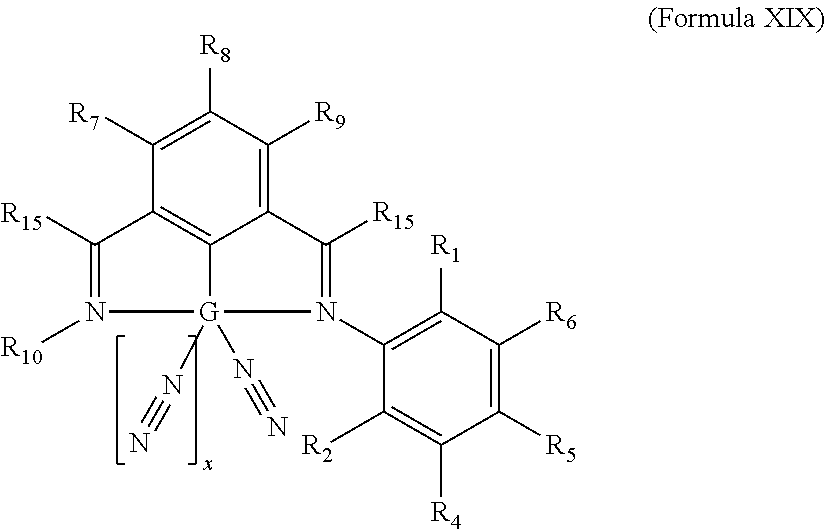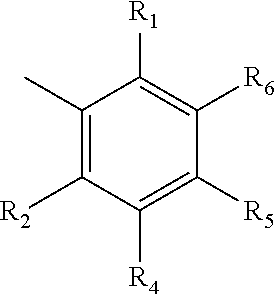Non-precious Metal-based Hyrdosilylation Catalysts Exhibiting Improved Selectivity
- Summary
- Abstract
- Description
- Claims
- Application Information
AI Technical Summary
Benefits of technology
Problems solved by technology
Method used
Image
Examples
example 1
Hydrosilylation of 1-octene with methylbis(trimethylsilyloxy)silane (MDHM) using (iPrPDI)Fe(N2)2
[0104]In a nitrogen-filled drybox, a 20 mL scintillation vial was charged with 335 mg (2.99 mmol) of 1-octene and 665 mg (2.99 mmol) of MDHM. The solution was stirred and 1 mg (0.002 mmol, 1×103 ppm catalyst loading) of (iPrPDI)Fe(N2)2 was added. After 15 minutes, the reaction was quenched by exposure to air. GC analysis of the product showed 99% conversion of 1-octene (retention time=1.33 min) to the hydrosilylated product (retention time=5.85 min). NMR analysis of the sample in benzene-d6 showed a signature peak for the α-hydrogens at 0.62 ppm.
example 2
Hydrosilylation of 1-octene with triethoxysilane using (iPrPDI)Fe(N2)2
[0105]In a nitrogen-filled drybox, a 20 mL scintillation vial was charged with 245 mg (2.18 mmol) of 1-octene and 360 mg (2.19 mmol) of triethoxysilane. The solution was stirred and 1 mg (0.002 mmol, 2×103 ppm catalyst loading) of (iPrPDI)Fe(N2)2 was added. After 15 minutes, the reaction was quenched by exposure to air. GC analysis of the product showed 99% conversion of 1-octene (retention time=1.33 min) to the hydrosilylated product (retention time=5.97 min).
example 3
Hydrosilylation of 1-octene with triethylsilane using (iPrPDI)Fe(N2)2
[0106]In a nitrogen-filled drybox, a 20 mL scintillation vial was charged with 290 mg (2.58 mmol) of 1-octene and 310 mg (2.67 mmol) of triethylsilane. The solution was stirred and 1 mg (0.002 mmol, 2×103 ppm catalyst loading) of (iPrPDI)Fe(N2)2 was added. After 60 minutes, the reaction was quenched by exposure to air. GC analysis of the product showed 4% conversion of 1-octene (retention time=1.33 min) to the hydrosilylated product (retention time=5.88 min).
PUM
| Property | Measurement | Unit |
|---|---|---|
| Structure | aaaaa | aaaaa |
| Ratio | aaaaa | aaaaa |
| Molar ratio | aaaaa | aaaaa |
Abstract
Description
Claims
Application Information
 Login to View More
Login to View More - R&D
- Intellectual Property
- Life Sciences
- Materials
- Tech Scout
- Unparalleled Data Quality
- Higher Quality Content
- 60% Fewer Hallucinations
Browse by: Latest US Patents, China's latest patents, Technical Efficacy Thesaurus, Application Domain, Technology Topic, Popular Technical Reports.
© 2025 PatSnap. All rights reserved.Legal|Privacy policy|Modern Slavery Act Transparency Statement|Sitemap|About US| Contact US: help@patsnap.com



